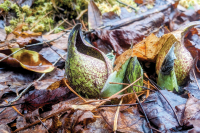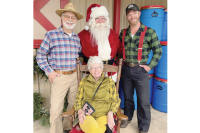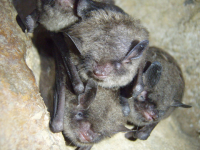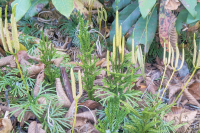Ahead of the CuRvE: Cullowhee group look to river park for downtown revitalization
 Downtown Cullowhee doesn’t look much like the thriving little town Rick Bennett found when he first moved to Jackson County in 1966. In the golden era of the 1970s, he reminisces, the little town boasted 17 restaurants, four gas stations, three grocery stores.
Downtown Cullowhee doesn’t look much like the thriving little town Rick Bennett found when he first moved to Jackson County in 1966. In the golden era of the 1970s, he reminisces, the little town boasted 17 restaurants, four gas stations, three grocery stores.
A far cry from the struggling crossroads in existence now, where cheap student housing fills buildings once inhabited by small businesses that just couldn’t make it and abandoned buildings punctuate the space between the few that have managed to stay open. The decline stems back to the construction of four-lane N.C. 107, which allowed traffic en route to Western Carolina University to bypass Cullowhee.
“Businesses couldn’t operate eight months out of the year or with traffic cut down to 3,000 cars a day,” Bennett said. “So businesses have steadily declined.”
Bennett’s just one member of a committed band of volunteers calling itself CuRvE, short for Cullowhee Revitalization Endeavor, working to reverse that decline. They’re hinging their hopes on one big project.
“We think it could be revitalized down there. But it needs an attraction,” said Maurice Phipps, parks and recreation professor at WCU and one of the forces behind CuRvE. “And a river park connected to the greenway would be a significant attraction.”
Related Items
Impact in dollars
It’s nothing new that CuRvE would like to see the banks of the Tuckasegee River through Cullowhee turn into a hangout place for families and river access for paddlers. They’ve been working in that direction for more than five years.
What is new is that their collective vision is now being translated onto paper. The mental images CuRvE members have been holding close are now being transformed into visual renderings and descriptions laced with dollars and cents.
“They’ve [Jackson County has] known for years that we have this idea,” said Anna Farriello, grant writer for CuRvE. “What we’re providing them with is some hard numbers to show that this will be economically good for the county.”
A $17,500 grant from the Blue Ridge Natural Heritage Partners last year gave CuRvE the money to commission an economic impact study for the project, as well as hire an intern and install some improved signage when the project has moved a little further along. The numbers from the economic impact study have just come back, and the CuRvE folks are already showing them off to county commissioners and the county’s economic development board.
According to the study, done by Tom Tveidt of Asheville-based Syneva Economics, the river park would bring $1.2 million in new spending to Jackson County every year. That money would support 16 jobs, add $375,000 in income and generate $145,000 in annual tax revenues. The extra cash would come from capturing part of the estimated $4.1 million spent each year on out-of-county outdoor recreation activities and attracting nonresidents to events and river-related recreation in Cullowhee.
“I suspect if the thing develops and gets some full steam, it would be a greater impact than that,” said County Manager Chuck Wooten. “And I think another impact would be to get some more development there in the old Cullowhee section.”
The CuRvE folks think so too. They see the park as a catalyst to transform Cullowhee into something more resembling a vibrant college town, a place full of unique hole-in-the-wall shops, outdoor seating — and people.
“With sustained traffic like a river park or a greenway or a community garden or all those activities, a sense of entrepreneurship will develop because there’s traffic. That’s what brings business,” Bennett said. “Can’t you imagine a nice café on the river where you look out and see people picnicking on the river and stuff like that?”
Rich Price, director of economic development for the county, agrees.
“There are a lot of instances around the country where the river parks, et cetera, have been established and growth in the area just flourished,” Price said, citing Greenville, S.C. as an example. “We certainly understand from an economic impact standpoint here in Jackson County that the Tuckasegee River is one of our most appealing assets, so we want to work to leverage that river.”
Visualizing an outcome
It’s pretty hard to picnic — or do much else, really — on that section of the Tuck right now. A guardrail separates Wayahutta — locally pronounced “Worry Hut”— Road from the river, and though some of the bank is grassy, much of it is overgrown with grass or poison ivy.
“Some people put their kayaks and canoes in there, but you have to climb over the guardrail, throw your kayak down there,” Fariello said. “You have to scramble down this hill.”
Looking at the overgrown bank, the aging concrete bridge, the abandoned buildings, it’s difficult to envision the idyllic park scene that CuRvE’s been carrying in its collective mind for the past several years.
That’s why they went for the $10,000 Toolbox grant from the Southwestern Commission to get a park design going and to produce some artistic renderings of what the finished product might look like. The design component is still in progress, but the renderings are done, giving CuRvE yet another springboard to move the project forward.
The drawings by Rachel Clegg of Clegg LA+Design, show couples strolling, joggers running, bikers pedaling and people walking their dogs on a concrete path winding alongside the river as picnickers eat at intermittent tables and paddlers put in on the bank. The river’s been worked on to provide paths for paddlers and boulders for picnickers to sit on, and there’s plenty of flatwater for people floating along in inner tubes.
“We hope we can then start to show people what it will actually look like,” Fariello said.
Rec in the backyard
If surveys are any indication, people will like what they see when CuRvE’s renderings become reality. The economic impact study was based partially off a survey by WCU professor Todd Collins of the Public Policy Institute, polling people in Cullowhee on how often they engage in outdoor recreation, how often they travel outside of the county to follow those pursuits and how their habits might change if a park were built.
“The main thrust of it was do you frequent either the businesses or the river in Cullowhee now, and mostly people said no,” Fariello said, “and the question posed to them was if these were to improve and be revitalized in any way would you frequent them and everyone was like, ‘Sure, yes.’ It was dramatic.”
According to the survey, 53.5 percent of respondents said they go outside of Jackson County more than four times per year to fish, tube, kayak or boat, while 35.5 percent said they’ve gone outside the county more than four times in the last year to bike, jog or walk. When asked how that would change if a river park were created in Cullowhee, 61.6 percent of respondents said they would stay in Jackson County to participate in water sports, and 44.9 percent said they’d stay in-county for the land-based recreation.
“My wife and I go to the Franklin greenway, which is great,” said Bennett, for whom Franklin is a 20-25-minute trip each way. “It’s a great greenway, but hopefully now we’ll be able to go two minutes and use the Jackson County greenway.”
For students at almost adjacent Western Carolina, driving 20 minutes to take a walk isn’t always an option. Which is another reason CuRvE is enthusiastic about the river park idea. The park would give students an easy way to escape to the outdoors and make the school’s physical connection to the town more fluid.
“As a resource for the university in general and for the [Base Camp] program in particular, the potential is huge,” said Josh Whitmore, director of Base Camp Cullowhee at WCU, after pausing for a moment on his lunchtime bike ride to do an interview. “The accessibility of being able to do programs right on campus or adjacent to campus is an amazing opportunity that’s needed.”
Boats, bridges and beautification
That opportunity isn’t quite reality yet, and it likely won’t be for quite a while. There’s money to be raised — CuRvE is still working on coming up with a price tag for the project — property owners to collaborate with and a land footprint to be worked out. For that last part, CuRvE is pinning its hopes on a bridge construction project that the N.C. Department of Transportation is gearing up to tackle.
“We started negotiating with DOT first for just a sidewalk on a bridge,” Fariello said. “That was all we wanted, but they agreed and then we started having a relationship with them and showing them that the community was really interested.”
The bridge will replace the 1940s-era structure now spanning the Tuckasegee River where Old Cullowhee Road hits it. The project will include a re-routing of Monteith and Wayehutta roads, and the whole thing will require the state to acquire some privately-owned property as right-of-way. In the DOT project, CuRvE saw an opportunity to capture the land it would need to create the longed-for river park.
“When DOT builds this bridge, they’re going to acquire land around the bridge,” Fariello explained. “They have to because they need a certain clearance around the bridge. When they have that land they don’t care what happens to it. It just becomes public land.”
The $4.6-million project will involve pieces of about 25 properties, a total of about 7 acres according to Teddy Green, DOT Right-of-Way Division agent.
“We’re getting one place where a person was living but they have since passed away,” Green said. “There’s one building we’ve got that’s got five or six renters in it. It’s mostly college students, I think. Three businesses that’s being acquired.”
The acquisitions are all part of a DOT project that would have occurred anyway, river park or no river park. However, CuRvE has been working with the DOT to make the final product more amenable to the park its members envision.
“The bridge is part of a pilot project for aesthetic enhancement so it will have some enhancements to it,” said Brian Burch, DOT engineer.
Rockform liner will make the bridge look like it’s built of rock, and the railing will have a rustic, brown color to it. The beams will be stained for a natural brown appearance, and the abutment holding the bridge up will be situated so as to allow for a 15-foot path on either side.
“One of them is allowed because of Jackson County’s greenway plan,” Burch said of the two path allowances. “The other one on the river park side was allowed because of the hydraulic opening that was required for this bridge.”
The business perspective
Though the land for the park will likely come as a byproduct of the state construction activity, more than anything else, some people say they would like to see more courting of and buy-in from area property owners before the more serious phases of planning and development begin.
“I’ve been to several of the CuRvE meetings and when I look around there’s only one or two property owners there and I’m one of them, so it’s kind of hard — if they’re not getting the property owners excited about it I don’t know how they think the park is going to happen,” said Jack Debnam, chairman of the Jackson County Commissioners.
But like the grant dollars, a lot of the community buy-in efforts are just beginning. Rachael Rodatz, owner of Tuck’s Tap & Grill, has only known about the project for a few weeks, learning about it from an ad in the newspaper. She’s never been to one of the CuRvE meetings Debnam referenced or seen the earlier stages of the plans, but she’s all for CuRvE’s grand vision.
“It sounds wonderful,” she said. “It sounds like it would be a place for people to go to and relax and enjoy Cullowhee for what it used to be.”
And, maybe, stick around for a while and get hungry enough for a meal at Tuck’s. Rodatz says the park project has been part of the conversation between area business owners, and the response is overwhelmingly positive.
“I think they’re all for it. There’s a lot of the businesses that it would just bring more people on that side,” she said.
Chris Pressley, owner of Cullowhee Auto Service and several adjacent buildings, isn’t quite so gung-ho.
“My family’s been here for 67-plus years, and we’re still here,” he said of his business. “It would definitely bring more traffic. Whether that would be a good thing or not, I don’t know.”
Meanwhile, Tim Newell’s thinking about the park in conjunction with Cullowhee River Club, a 282-unit development he’s building with entrances on Wayehutta and Old Cullowhee roads.
“Any park in the community certainly is an amenity, and it’s a good thing,” Newell said. “We view it as a possibility and another thing to talk about when you talk about Cullowhee.”
He’s cautious about lauding the not-yet-existent park as something that will boost the values of the homes he’s just now starting to build or increase desirability to the point that they sell like hotcakes. But he certainly sees the plan as a perk.
“It is on the checklist that you look for when you look for a place to do economic development, but really it’s another amenity to add to the list,” he said.
Getting there
But it’s not added yet. Before any park can go in, the bridge has to be completed, for one thing. Burch expects it to be let to contract in June 2015 and from there take one-and-a-half to two years. Construction time is lengthy because it will be built one half at a time so traffic can continue to cross the river on one lane while the other is being constructed.
And once the project’s done, CuRvE will have to have some funding behind it before the park materializes. Walking paths, picnic tables, restrooms, parking, signage, in-stream flow modifications — it will all cost some money. How much, the organization will know pending the outcome of a report from three-time Olympic slalom kayaker and owner of Colorado-based S20 Designs Scott Shipley, expected by the end of October. That’s when the fundraising will begin.
“We’ll take those pieces and start to look for some serious money,” Fariello said. “We have to get buy-in by the community.”
“The combination of Rachel [Clegg]’s drawing and the real plan, we can say this is exactly what we’re doing so we can then go and fundraise based on an accurate figure,” added Phipps.
As a nonprofit group of interested citizens, CuRvE doesn’t have any money of its own. The group hopes to fund the project through a hodgepodge of grants, sponsorships and partnerships from area businesses and organizations as well as funding from county and municipal government.
“Just like anything else, it starts with an idea and grows and people see the potential benefit,” Bennett said. “It’s going to take partnerships for design. It’s going to take partnerships for funding.”
And, at the end of the day, result in a revitalized downtown that gives families a place to go enjoy the river, Cullowhee a more college-town kind of feel and jobs for people who work in the coffee shops, boutiques and kayak rental stores that CuRvE envisions springing up when fertilized by the increased traffic generated by the park.
“The river is just an amazing asset, and we want to take advantage of it, but we want to take advantage of it in a sustainable way,” Fariello said.
The project in a nutshell
CuRvE started out as an organization loosely organized around the concept of beautification and economic development in Cullowhee, but now its main focus is the river park project. CuRvE would like to see the section of the Tuckasegee River around the Old Cullowhee Road bridge transformed into a small park with picnic tables, a walking path, and access to the river.
The Lena Davis put-in just above the Cullowhee Dam coupled with the new put-in at Locust Creek would give paddlers a 3.5-mile stretch of river to enjoy, and once the Jackson County Greenway reaches its full planned length — something that will likely take a good many years, given that it involves negotiating with private property owners — it would connect to the river park path. The path would also reach the nearby Cullowhee Community Garden.
CuRvE sees the park as a way to give locals and college students a place to hang out and a way to give businesses a boost by drawing traffic to a languishing downtown.













